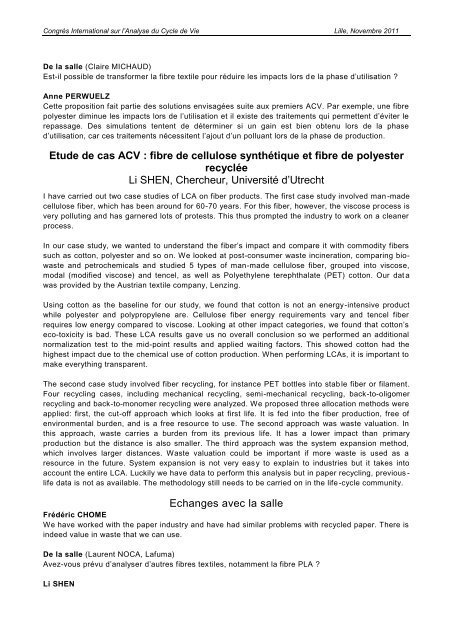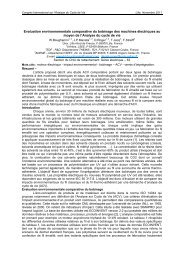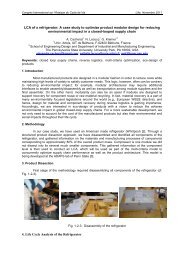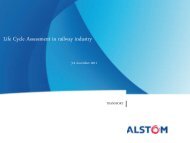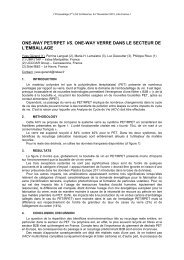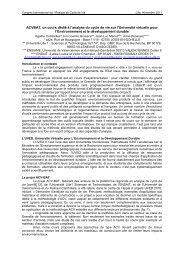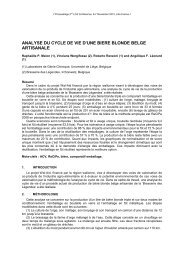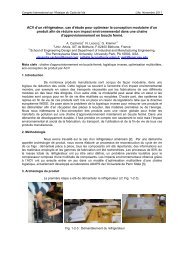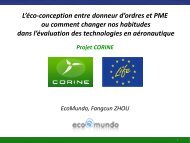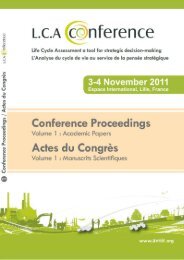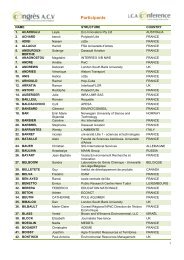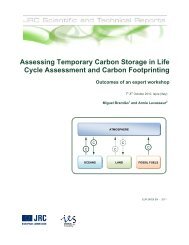Congrès International sur l'Analyse du Cycle de Vie Lille ... - avniR
Congrès International sur l'Analyse du Cycle de Vie Lille ... - avniR
Congrès International sur l'Analyse du Cycle de Vie Lille ... - avniR
Create successful ePaper yourself
Turn your PDF publications into a flip-book with our unique Google optimized e-Paper software.
Congrès <strong>International</strong> <strong>sur</strong> l’Analyse <strong>du</strong> <strong>Cycle</strong> <strong>de</strong> <strong>Vie</strong> <strong>Lille</strong>, Novembre 2011<br />
De la salle (Claire MICHAUD)<br />
Est-il possible <strong>de</strong> transformer la fibre textile pour ré<strong>du</strong>ire les impacts lors d e la phase d’utilisation ?<br />
Anne PERWUELZ<br />
Cette proposition fait partie <strong>de</strong>s solutions envisagées suite aux premiers ACV. Par exemple, une fibre<br />
polyester diminue les impacts lors <strong>de</strong> l’utilisation et il existe <strong>de</strong>s traitements qui permettent d’éviter le<br />
repassage. Des simulations tentent <strong>de</strong> déterminer si un gain est bien obtenu lors <strong>de</strong> la phase<br />
d’utilisation, car ces traitements nécessitent l’ajout d’un polluant lors <strong>de</strong> la phase <strong>de</strong> pro<strong>du</strong>ction.<br />
Etu<strong>de</strong> <strong>de</strong> cas ACV : fibre <strong>de</strong> cellulose synthétique et fibre <strong>de</strong> polyester<br />
recyclée<br />
Li SHEN, Chercheur, Université d’Utrecht<br />
I have carried out two case studies of LCA on fiber pro<strong>du</strong>cts. The first case study involved man -ma<strong>de</strong><br />
cellulose fiber, which has been around for 60-70 years. For this fiber, however, the viscose process is<br />
very polluting and has garnered lots of protests. This thus prompted the in<strong>du</strong>stry to work on a cleaner<br />
process.<br />
In our case study, we wanted to un<strong>de</strong>rstand the fiber’s impact and compare it with commodity fibers<br />
such as cotton, polyester and so on. We looked at post-consumer waste incineration, comparing biowaste<br />
and petrochemicals and studied 5 types of man-ma<strong>de</strong> cellulose fiber, grouped into viscose,<br />
modal (modified viscose) and tencel, as well as Polyethylene terephthalate (PET) cotton. Our dat a<br />
was provi<strong>de</strong>d by the Austrian textile company, Lenzing.<br />
Using cotton as the baseline for our study, we found that cotton is not an energy-intensive pro<strong>du</strong>ct<br />
while polyester and polypropylene are. Cellulose fiber energy requirements vary and tencel fiber<br />
requires low energy compared to viscose. Looking at other impact categories, we found that cotton’s<br />
eco-toxicity is bad. These LCA results gave us no overall conclusion so we performed an additional<br />
normalization test to the mid-point results and applied waiting factors. This showed cotton had the<br />
highest impact <strong>du</strong>e to the chemical use of cotton pro<strong>du</strong>ction. When performing LCAs, it is important to<br />
make everything transparent.<br />
The second case study involved fiber recycling, for instance PET bottles into stab le fiber or filament.<br />
Four recycling cases, including mechanical recycling, semi-mechanical recycling, back-to-oligomer<br />
recycling and back-to-monomer recycling were analyzed. We proposed three allocation methods were<br />
applied: first, the cut-off approach which looks at first life. It is fed into the fiber pro<strong>du</strong>ction, free of<br />
environmental bur<strong>de</strong>n, and is a free resource to use. The second approach was waste valuation. In<br />
this approach, waste carries a bur<strong>de</strong>n from its previous life. It has a lower impact than primary<br />
pro<strong>du</strong>ction but the distance is also smaller. The third approach was the system expansion method,<br />
which involves larger distances. Waste valuation could be important if more waste is used as a<br />
resource in the future. System expansion is not very eas y to explain to in<strong>du</strong>stries but it takes into<br />
account the entire LCA. Luckily we have data to perform this analysis but in paper recycling, previous -<br />
life data is not as available. The methodology still needs to be carried on in the life -cycle community.<br />
Echanges avec la salle<br />
Frédéric CHOME<br />
We have worked with the paper in<strong>du</strong>stry and have had similar problems with recycled paper. There is<br />
in<strong>de</strong>ed value in waste that we can use.<br />
De la salle (Laurent NOCA, Lafuma)<br />
Avez-vous prévu d’analyser d’autres fibres textiles, notamment la fibre PLA ?<br />
Li SHEN


